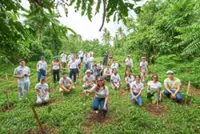TRCRC conducts nursery management training. Pictured here is the Kampung Klewang seedling nursery in Perak.
EARTH is home to over 3 trillion trees. Restoration ecologists have mapped out the global potential for restoration and estimated 0.9 billion hectares where trees can grow outside of urban and agricultural areas which is space for 1 trillion new trees.
In recent years, a global tree-planting movement has taken hold with the realised potential of trees as a nature-based solution to capture carbon from the atmosphere and get us closer to net zero emissions. There is an increased interest from the general public, government agencies, and corporate bodies to plant as many trees as possible, wherever possible.





